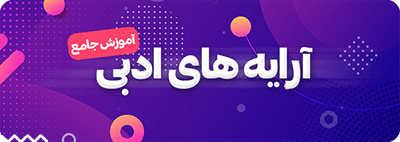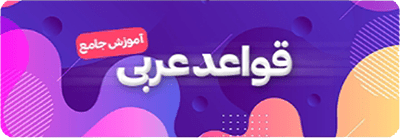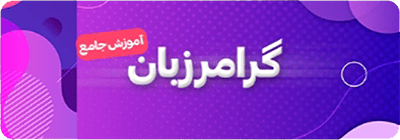جواب فصل 1 Underestanding People زبان انگلیسی یازدهم
تعداد بازدید : 3.12Mپاسخ به تمامی سوالات فصل Underestanding People - حل المسائل فصل 1 Underestanding People - گام به گام 1401 کتاب زبان انگلیسی یازدهم - گام به گام کتاب زبان انگلیسی یازدهم مطابق با آخرین تغییرات کتب درسی
Get Ready صفحه 17 درس Underestanding People زبان انگلیسی یازدهم
پاسخ Get Ready صفحه 17 درس 1
جواب Get Ready صفحه 17 درس 1 زبان انگلیسی یازدهم
.A. Look at the map. Choose six countries and write their languages
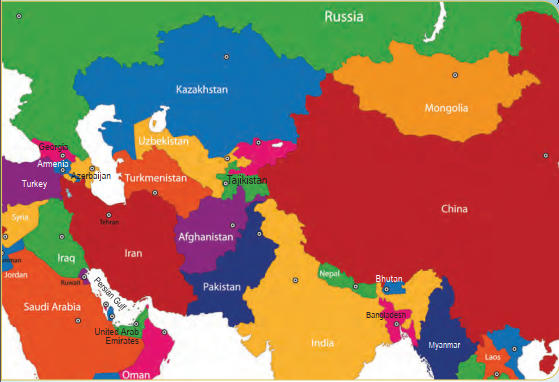
.Are you familiar with any of the above languages? If yes, circle them
.B. Match the signs with their meanings. There is one extra sentence
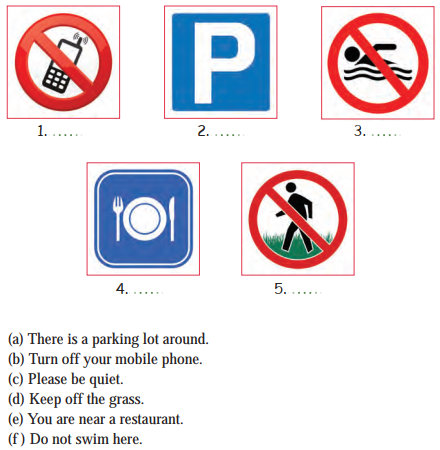
C. Number the following activities from 1 to 6 according to how frequently you do them when you learn a foreign language
Reading storybooks Watching movies
Listening to the news Surf ing the net
Talking to foreigners Writing letters or emails
.A
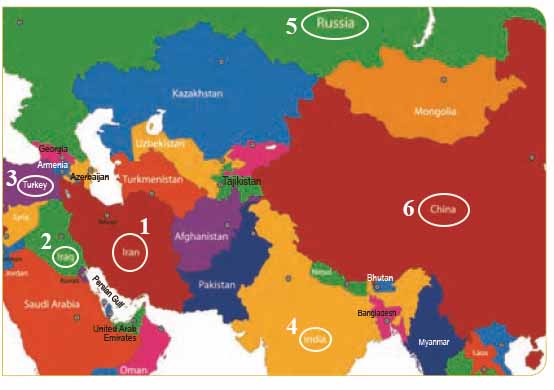
1) Persian 2) Arabic 3) Turkish 4) Indian
5) Russian 6) Chinese
.B
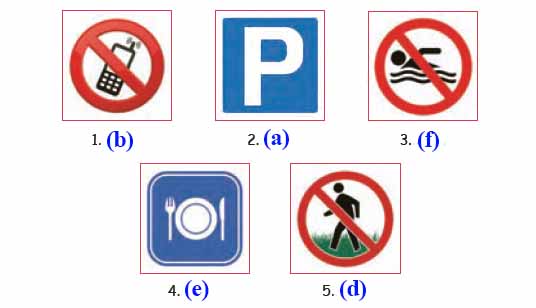
.(a) There is a parking lot around
.(b) Turn off your mobile phone
.(c) Please be quiet
.(d) Keep off the grass
.(e) You are near a restaurant
.(f) Do not swim here
C.
1) Watching movies
2) Surfing the net
3) Listening to the news
4) Reading storybooks
5) Talking to foreigners
6) Writing letters or emails
آ) به نقشه نگاه کنید. شش کشور را انتخاب کرده و زبان آن ها را بنویسید.
1) فارسی 2) عربی 3) ترکی 4) هندی
5) روسی 6) چینی
آیا شما با زبان کشوری از کشورهای بالا آشنایی دارید؟ اگر جواب مثبت است دور آن خط بکشید.
ب) علامت ها را با معنی هایشان تطبیق دهید. یک جمله اضافی وجود دارد.
آ) در این نزدیکی، محوطه پارک ماشین وجود دارد.
ب) گوشی موبایلتان را خاموش کنید.
پ) لطفا ساکت باشید.
ت) وارد چمن نشوید.
ث) شما نزدیک یک رستوران هستید.
ج) در این جا شنا نکنید.
ج) فعالیت های زیر را از شماره تا شماره گذاری کنید. بر این مبنا که برای مکالمه زبان انگلیسی اولویت های شما کدام ها هستند.
مطلعه کتاب داستان تماشا کردن فیلم
گوش کردن به اخبار وب گردی
صحبت کردن با خارجی ها نامه یا ایمیل نوشتن
مای درس ، برترین اپلیکیشن کمک درسی ایران
پوشش تمام محتواهای درسی پایه یازدهم- آزمون آنلاین تمامی دروس پایه یازدهم
- گام به گام تمامی دروس پایه یازدهم
- ویدئو های آموزشی تمامی دروس پایه یازدهم
- گنجینه ای از جزوات و نمونه سوالات تمامی دروس پایه یازدهم
- فلش کارت های آماده دروس پایه یازدهم
- گنجینه ای جامع از انشاء های آماده پایه یازدهم
- آموزش جامع آرایه های ادبی، دستور زبان، قواعد زبان انگلیسی و ... ویژه پایه یازدهم
Conversation صفحه 19 درس Underestanding People زبان انگلیسی یازدهم
پاسخ Conversation صفحه 19 درس 1
جواب Conversation صفحه 19 درس 1 زبان انگلیسی یازدهم
Babak Saberian is a translator who works for IRIB. Today, he is hosting Meysam in his office. Meysam is a high school student. He is interviewing Mr. Saberian for his school project.
Meysam: Thank you Mr. Saberian for inviting me to your office.
Mr. Saberian: You’re welcome!
Meysam: I heard you know three languages. Is that right?
Mr. Saberian: Well, actually four languages.
Meysam: Four! Really?! What languages do you know?
Mr. Saberian: Besides my mother tongue, Persian, I know English, French and Russian well.
Meysam: Interesting! And when did you learn them?
Mr. Saberian: I began learning English at school when I was thirteen. Then I began learning French in a language institute
when I was fifteen. And I learned Russian when I was a university student in Moscow
Meysam: Can you use all of them fluently?
Mr. Saberian: I know all of them well, but I use English more.
Meysam: OK. Do you think language learning should start as early as possible?
Mr. Saberian: My experience says interest and hard work are really more important than age.
Meysam: Hmm… that’s an important point. May I know what your favorite language is ? English, French, or Russian?
Mr. Saberian: To be honest, I enjoy using them all, but my favorite language is absolutely my mother tongue!
Question
Answer the following questions orally.
1. Where does Mr. Saberian work?
2. Was Mr. Saberian living in a foreign country when he was 13?
3. How many languages do you know?
Question
1. Where does Mr. Saberian work?
He works for IRIB.
2. Was Mr. Saberian living in a foreign country when he was 13?
No, he lived in Iran when he was 13.
3. How many languages do you know?
I know 2 languages.
مکالمه
بابک صابریان مترجمی است که برای صدا و سیمای جمهوری اسلامی ایران کار می کند. امروز او در دفترش میزبان میثم است. میثم دانش آموز دبیرستان است. او با آقای صابریان برای پروژه مدرسه اش صاحبه می کند.
میثم: آقای صابریان بابت این که من را به دفترتان دعوت کردید، متشکرم.
آقای صابریان: خواهش می کنم.
میثم: من شنیده ام شما 3 زبان بلد هستید، درست است؟
آقای صابریان: خب، در واقع 4 زبان.
میثم: 4 تا؟ واقعا؟ چه زبان هایی بلدید؟
آقای صابریان: علاوه بر زبان مادریم فارسی، انگلیسی، فرانسوی و روسی را به خوبی بلدم.
میثم: جالب است. و شما کِی آن ها را یاد گرفتید؟
آقای صابریان: من وقتی 13 ساله بودم شروع به یادگیری انگلیسی در مدرسه کردم. سپس وقتی 15 ساله شدم. شروع به یادگیری فرانسوی در آموزشگاه زبان کردم و روسی را وقتی در مسکو دانشجو بودم یاد گرفتم.
میثم: آیا می توانید از همه آن ها به صورت روان استفاده کنید؟
آقای صابریان: من همه آن ها را به خوبی بلدم اما بیشتر از (زبان) انگلیسی استفاده می کنم.
میثم: بسیار خب، آیا شما فکر می کنید یدگیری زبان باید هر چه زودتر شروع شود؟
آقای صابریان: تجربه من می گوید علاقه و سخت کوشی نسبت به سن واقعا مهمتر هستند.
میثم: همم – این نکته مهمی است. می توانم بدانم زبان مورد علاقه شما چیست؟ انگلیسی، فرانسه یا روسی؟
آقای صابریان: اگر راستش را بخواهی، من از استفاده همه آن ها لذت می برم اما زبان مورد علاقه من مطلقا زبان مادریم است.
سؤالات مکالمه
به سؤالات زیر به طور شفاهی پاسخ دهید.
* آقای صابریان کجا کار می کند؟
او در صدا و سیمای جمهوری اسلامی کار می کند.
** زمانی که او 13 ساله بود، آیا آقای صابریان در کشور خارج زندگی می کرد؟
خیر، او در ایران بود وقتی 13 ساله بود.
*** چه تعداد زبان خارجی یاد دارید؟
من 2 زبان (خارجی) بلدم.
گام به گام کتاب های پایه یازدهم
گام به گام جامع کتاب فارسی یازدهم
گام به گام جامع کتاب نگارش یازدهم
گام به گام جامع کتاب زبان انگلیسی یازدهم
گام به گام جامع کتاب کتاب کار انگلیسی یازدهم
گام به گام جامع کتاب انسان و محیط زیست
Reading صفحه 24 درس Underestanding People زبان انگلیسی یازدهم
پاسخ Reading صفحه 24 درس 1
جواب Reading صفحه 24 درس 1 زبان انگلیسی یازدهم
Languages of the World.
Language is a system of communication. It uses written and spoken forms. People use language to communicate with each other in a society. They exchange knowledge, beliefs, wishes, and feelings through it.
Languages vary greatly from region to region. They are so different that a person may not understand the language of someone from another region, country or continent. It is not surprising to hear that today about 7000 languages exist in the world. There are more than 2000 languages in Africa, 1000 in the Americas, more than 2250 in Asia, about 230 in Europe, and more than 1300 in Oceania.
Native speakers of these languages range in number from very large, with hundreds of millions of speakers, to very small, with fewer than 10 speakers. The most popular language in the world is Chinese.
More than one billion people in the world speak Chinese. Interestingly, English has fewer native speakers than Chinese, but there are about one billion learners of English all around the world. They learn English as an international language.
About fifty percent of the world’s languages have fewer than 5000 speakers. In the beginning of the twenty-first century, 204 languages had fewer than 10 speakers and 344 languages had between 10 and 99 speakers. The 548 languages with fewer than 99 speakers make up nearly 8 percent of the world’s languages. We call them ‘endangered languages’. As the speakers of such languages grow old and die, their languages will die, too.
All languages are really valuable, despite their differences. Every language is an amazing means of communication that meets the needs of its own speakers. It is impossible to imagine the world without language. Therefore, we should respect all languages, no matter how different they are and how many speakers they have.
Reading Comprehensive
A. Scan the passage for the following numbers. Match them with the information. There is one extra number.
a. 548 b. 2250 c. 8 d. 1300 e. 204
1. The number of languages with speakers fewer than 10
2. The percent of endangered languages
3. The number of languages with speakers fewer than 99
4. The number of languages in Oceania
B. Scan the passage for the proper nouns.
a) The language with more than one billion learners:
b) The continent with one thousand languages:
c) The language with the largest number of native speakers:
C. Scan the passage and answer the following questions.
a) How many languages are there in the world?
b) What is the number of endangered languages?
c) Which continent has the largest number of languages in the world?
D. Read the sentences; put T for true and F for false. If a sentence is false, correct it.
a) Through languages, people can exchange only knowledge. T F
b) When a language has no speaker, it dies out. T F
c) Only a few languages can meet the needs of their own speakers. T F
Languages of the World
Language is a system of communication. It uses written and spoken forms. People use language to communicate with each other in a society. They exchange knowledge, beliefs, wishes, and feelings through it.
Languages vary greatly from region to region. They are so different that a person may not understand the language of someone from another region, country or continent. It is not surprising to hear that today about 7000 languages exist in the world. There are more than 2000 languages in Africa, 1000 in the Americas, more than 2250 in Asia, about 230 in Europe, and more than 1300 in Oceania.
Native speakers of these languages range in number from very large, with hundreds of millions of speakers, to very small, with fewer than 10 speakers. The most popular language in the world is Chinese.
More than one billion people in the world speak Chinese. Interestingly, English has fewer native speakers than Chinese, but there are about one billion learners of English all around the world. They learn English as an international language.
About fifty percent of the world’s languages have fewer than 5000 speakers. In the beginning of the twenty-first century, 204 languages had fewer than 10 speakers and 344 languages had between 10 and 99 speakers. The 548 languages with fewer than 99 speakers make up nearly 8 percent of the world’s languages. We call them ‘endangered languages’. As the speakers of such languages grow old and die, their languages will die, too.
All languages are really valuable, despite their differences. Every language is an amazing means of communication that meets the needs of its own speakers. It is impossible to imagine the world without language. Therefore, we should respect all languages, no matter how different they are and how many speakers they have.
Reading Comprehensive
A.
1. The number of languages with speakers fewer than 10 : e. 204
2. The percent of endangered languages : c. 8
3. The number of languages with speakers fewer than 99 : a. 548
4. The number of languages in Oceania : d. 1300
B.
a) The language with more than one billion learners: English
b) The continent with one thousand languages: America
c) The language with the largest number of native speakers: Chinese
C.
a) How many languages are there in the world?
There are about 7000 languages in the world.
b) What is the number of endangered languages?
The 548 languages.
c) Which continent has the largest number of languages in the world?
Asia with the 2250 languages has the largest number.
D.
a) Through languages, people can exchange only knowledge. False
b) When a language has no speaker, it dies out. True
c) Only a few languages can meet the needs of their own speakers. False
خواندن
زبان سامانه ای از ارتباطات است. زبان به شکل های نوشتاری و گفتاری به کار می رود. مردم در یک جامعه زبان را برای ارتباط با هم بکار می برند. مردم دانش، اعتقادات، خواسته ها و احساساتشان را از طریق آن مبادله می کنند.
زبان ها از یک ناحیه به ناحیه دیگر به طور گسترده ای تغییر می کنند. زبان ها به قدری متفاوتند که یک نفر ممکن است زبان شخصی از ناحیه، کشور یا قاره دیگر را درک نکند. شگفت آور نیست بدانید که حدود 7000 زبان در دنیا وجود دارد. بیش از 2000 زبان در آفریقا، 1000 تا در آمریکاها، بیش از 2250 در آسیا، حدود 230 تا در اروپا و بیش از 1300 تا در اقیانوسیه وجود دارد.
تعداد متکلمین بومی این زبان ها از خیلی زیاد – با چند صد میلیون متکلم – تا خیلی کم – تا کمتر از 10 متکلم – تغییر می کند. رایجترین زبان دنیا چنینی است. بیش از یک میلیارد نفر در دنیا، چینی صحبت می کند. رایجترین زبان دنیا چینی است.
بیش از یک میلیارد نفر در دنیا، چینی صحبت می کنند. متکلمین به زبان انگلیسی به طور جالب توجهی نسبت به چینی کمتر هستند اما در سراسر دنیا حدود یک میلیارد یادگیرنده انگلیسی وجود دارد. آن ها زبان انگلیسی را به عنوان یک زبان بین المللی یاد می گیرند.
حدود 50 درصد زبان های جهان کمتر از 5000 متکلم دارند. در شروع قرن 21 ام 204 زبان کمتر از 10 متکلم و 344 زبان بین 10 الی 99 متکلم داشتند. 548 زبان با کمتر از 99 متکلم حدود 8 درصد زبان های دنیا را تشکیل می دهند. ما آن ها را زبان های در معرض انقراض می نامیم. همان طور که متکلمین این زبان ها پیر می شوند و می میرند، زبان هایشان هم خواهند مرد. با وجود تفاوت هایشان،
همه زبان ها واقعا ارزشمندند. هر زبانی یک ابزار شگفت انگیز ارتباطات است که نیازهای گویندگان خودش را برطرف می کند. تصور جهان بدون زبان غیر ممکن است. بنابراین ما باید به همه زبان ها احترام بگذاریم. مهم نیست که زبان ها چقدر با هم متفاوتند و چند گوینده دارند.
درک مطلب خواندن
الف) اعداد زیر را در متن جستجو کنید. سپس با اطلاعات مطابقت دهید. یک عدد اضافی است.
1) تعداد زبان های با کمتر از 10 متکلم
2) درصد زبان های در معرض خطر
3) تعداد زبان های با کمتر از 99 متکلم
4) تعداد زبان های اقیانوسیه
پ) متن را سریع بخوانید و اسامی مناسب (برای جملات زیر) پیدا کنید.
آ) زبانی با بیش از یک میلیارد یاد گیرنده : انگلیسی
ب) قاره ای با یک هزار زبان : آمریکا
پ) زبانی با بیشترین تعداد متکلم بومی : چینی
پ) متن را اسکن کنید و به سؤالات زیر پاسخ دهید.
آ) چه تعداد زبان در جهان وجود دارد؟
حدود 7000 زبان در جهان وجود دارد.
ب) زبان های در حال انقراض چه تعداد است؟
548 زبان.
ج) کدام قاره بیشترین تعداد زبان را در جهان دارد؟
آسیا با در بر داشتن 2250 زبان بیشترین تعداد زبان را دارد.
ت) جملات را بخوانید. در جلوی جملات درست حرف T در جلوی جملات اشتباه حرف F قرار دهید.
آ) مردم از طریق زبان ها فقط می توانند دانش را مبادله کنند.
ب) مردم به کمک زبان می توانند دانش، باورها، خواسته ها و احساسات خود را مبادله کنند.
ج) فقط تعداد کمی از زبان ها هستند که می توانند نیازهای متکلمین خود را برآورده کنند.
Vocabulary Development صفحه 27 درس Underestanding People زبان انگلیسی یازدهم
پاسخ Vocabulary Development صفحه 27 درس 1
جواب Vocabulary Development صفحه 27 درس 1 زبان انگلیسی یازدهم
SYNONYMS
Synonyms are words with similar meanings, for example, ‘hard’ and ‘difficult’; or ‘begin’ and ‘start’ are synonyms. Learning synonyms is a good way to develop our vocabulary.
A. Write the words that mean the same under the picture where they belong.
small powerful quick strong
fast tiny simple easy
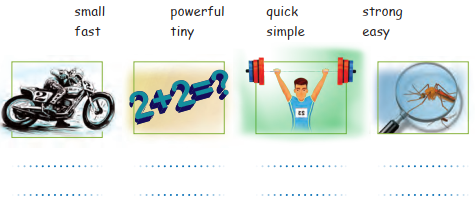
B. Two of the words in each group are synonyms. Find them.
a) amazing/ probable/ wonderful b) seek/ search for/ exercise
c) quit/ live/ give up d) fortunately/ luckily/ really
C. Look back at the Reading to find synonyms for the words.
a) In paragraph 2, find a synonym for ‘largely’:
b) In paragraph 4, find a synonym for ‘nearly’:
c) In paragraph 5, find a synonym for ‘to form’:
d) In paragraph 6, find a synonym for ‘to think of’:
Vocabulary Development
SYNONYMS
Synonyms are words with similar meanings, for example, ‘hard’ and ‘difficult’; or ‘begin’ and ‘start’ are synonyms. Learning synonyms is a good way to develop our vocabulary.
A.

B.
a) amazing - wonderful b) seek - search for
c) quit - give up d) fortunately - luckily
C.
a) In paragraph 2, find a synonym for ‘largely’: greatly
b) In paragraph 4, find a synonym for ‘nearly’: about
c) In paragraph 5, find a synonym for ‘to form’: make up
d) In paragraph 6, find a synonym for ‘to think of’: imagine
مترادف ها:
مترادف ها کلماتی هستند که معنی های مشابه دارند. مثل دو کلمه hard و difficult. یا مثل دو کلمه begin و start که دو به دو مترادف هستند. یاد گرفتن مترادف کلمات راه خوبی برای گسترش دامنه لغت است.
الف) در تصویر های زیر، در زیر هر تصویر دو کلمه مترادف مربوطه را بنویسید.
کوچک قدرتمند سریع قوی
سریع کوچک ساده راحت
ب) در هر گروه زیر دو تا از کلمات مترادف هستند؛ آن ها را بیابید.
آ) شگفت آور – باور نکردنی – حیرت آور
ب) جستجو کردن – جستجو کردن چیزی – ورزش کردن
ج) دست کشیدن – زندگی کردن – استعفا دادن
د) خوشبختانه – خوشبختانه – واقعا
پ) به متن ریدینگ مراجعه کنید و مترادف کلمات زیر را بیابید.
آ) در پاراگراف 2، هم معنی کلمه «به بزرگی» را بیابید.
ب) در پاراگراف 4، یک هم معنی برای «در نزدیکی» را بیابید.
ج) در پاراگراف 5، یک هم معنی برای «ساختن» پیدا کنید.
د) در پاراگراف 6، یک هم معنی برای «فکر کردن، تصور کردن» پیدا کنید.
مای درس ، برترین اپلیکیشن کمک درسی ایران
پوشش تمام محتواهای درسی پایه یازدهم- آزمون آنلاین تمامی دروس پایه یازدهم
- گام به گام تمامی دروس پایه یازدهم
- ویدئو های آموزشی تمامی دروس پایه یازدهم
- گنجینه ای از جزوات و نمونه سوالات تمامی دروس پایه یازدهم
- فلش کارت های آماده دروس پایه یازدهم
- گنجینه ای جامع از انشاء های آماده پایه یازدهم
- آموزش جامع آرایه های ادبی، دستور زبان، قواعد زبان انگلیسی و ... ویژه پایه یازدهم
Grammer صفحه 28 درس Underestanding People زبان انگلیسی یازدهم
پاسخ Grammer صفحه 28 درس 1
جواب Grammer صفحه 28 درس 1 زبان انگلیسی یازدهم
A. Read the following texts.
An endangered language is a language that has very few speakers. Nowadays, many languages are losing their native speakers. When a language dies, the knowledge and culture disappear with it. A lot of endangered languages are in Australia and South America. Some of them are in Asia and Africa. The number of live languages of the world is around 7000, and many of them may not exist in the future. Many researchers are now trying to protect endangered languages. This can save lots of information and cultural values of people all around the world.
There are many uncountable words for food in English. Native speakers often use words such as ‘a bag of, ‘two slices of’, or ‘a piece of’ with uncountable nouns. This usually happens when they go shopping. They may ask for two bottles of water, a bag of sugar, a loaf of bread, or two kilos of meat. In a coffee shop, they may order a cup of tea, a piece of cake, or a glass of juice. If a foreign learner uses uncountable words wrongly, English speakers may not understand them well. So when you learn English, be very careful about this important point.
C. Tell your teacher how different ‘countable’ and ‘uncountable nouns’ are.
D. Underline all ‘countable and uncountable nouns’ in Reading.
E. Choose appropriate words to complete the following sentences.
1. The students need to read (many/much) books about history.
2. Please buy (a loaf of/a bottle of) bread for breakfast.
3. Children should drink (a lot of/a few) milk.
4. We did not have (much/many) visitors this week.
5. Could you please bring me (a glass of/a piece of) water?
F. Pair up and ask and answer the following questions.
1. How many books did you read in summer?
2. How much milk do you drink each day?
3. How much money do you save each month?
4. How many pencils do you have in your bag?
An endangered language is a language that has very few speakers. Nowadays, many languages are losing their native speakers. When a language dies, the knowledge and culture disappear with it. A lot of endangered languages are in Australia and South America. Some of them are in Asia and Africa. The number of live languages of the world is around 7000, and many of them may not exist in the future. Many researchers are now trying to protect endangered languages. This can save lots of information and cultural values of people all around the world.
There are many uncountable words for food in English. Native speakers often use words such as ‘a bag of, ‘two slices of’, or ‘a piece of’ with uncountable nouns. This usually happens when they go shopping. They may ask for two bottles of water, a bag of sugar, a loaf of bread, or two kilos of meat. In a coffee shop, they may order a cup of tea, a piece of cake, or a glass of juice. If a foreign learner uses uncountable words wrongly, English speakers may not understand them well. So when you learn English, be very careful about this important point.
C.
پاسخ در قسمت ترجمه (پایین صفحه) امده است.
D.
Countable nouns: speaker - language - researcher - word - v
Uncountable nouns : water - sugar - bread - juice
E. Choose appropriate words to complete the following sentences.
1. The students need to read (many) books about history.
2. Please buy (a loaf of) bread for breakfast.
3. Children should drink (a lot of) milk.
4. We did not have (many) visitors this week.
5. Could you please bring me (a glass of) water?
F. Pair up and ask and answer the following questions.
1. I read 3 books.
2. I drink a lot of milk every day.
3. I save about 20,000 Tomans.
4. I have 2 pencils in my bag.
گرامر
آ) متن های زیر را بخوانید.
زبان در حال انقراض به بانی گفته می شود که دارای تعداد کمی متکلم هست. امروزه زبان های زیادی متکلم های بومی خود را از دست داده اند. وقتی یک زبان از بین می رود، دانش و فرهنگ نیز با آن از بین می رود. تعداد زیادی از زبان های در حال انقراض در استرالیا و آمریکای جنوبی هستند. یعضی از آن ها در آسیا و آفریقا هستند. تعداد زبان های زنده جهان حدود 7000 است و خیلی از آن ها ممکن است در آینده وجود نداشته باشند. محققان زیادی اکنون جهت حفاظت از زبان های در حال انقراض تلاش می کنند. این کار می تواند بسیازی از اطلاعات و ارزش های فرهنگی مردم سراسر جهان را حفظ کند.
کلمات غیر قابل شمارش زیادی در انگلستان برای غذا وجود دارد. متکلمان بومی از ده کلمه مانند یک بسته از، دو تکه از، یا یک قطعه از و ... را به همراه کلمات غیر قابل شمارش به کار می برند. این ها معمولا زمانی اتفاق می افتند که به خرید می روند. آن ها ممکن است از : دو بطری آب، یک بسته شکر، یک قرص نان یا دو کیلو گوشت استفاده کنند. در کافی شاپ، آن ها یک فنجان چای، یک قطعه کیک، یک لیوان شربت سفارش می دهند. اگر یک یادگیرنده خارجی از کلمات غیر قابل شمارش به اشتباه استفاده کند، انگلیس زبانان ممکن است به درستی متوجه نشوند. بنابراین زمانی که انگلیسی یاد می گیرید، در مورد این نکته مهم مراقب باشید.
پ) به معلم خود بگویید که چه فرقی بین اسامی شمارشی و غیر شمارشی وجود دارد.
اسم های شمارشی: با s و es جمع بسته می شوند. قبل از مفرد آن ها معمولا a یا an می آید.
Bird, boy, basket
اسم های غیر شمارشی: این اسامی قابل شمارش نیستند. این اسم ها به صورت مفرد در جمله ظاهر می شوند و هنگام استفاده از آن ها از عبارت هایی مثل قطعه، لیون، کیلو و بسته و ... استفاده می کنیم.
Soup, bread, milk, information, tea
ت) زیر تمامی اسامی شمارشی و غیر شمارشی موجود در ریدینگ خط بکشید.
ث) کلمات مناسبی را برای تکمیل کردن جملات زیر انتخاب کنید.
1) دانش آموزان لازم دارند که در مورد تاریخ کتاب های زیادی بخوانند.
2) لطفا برای صبحانه یک قرص نان بخرید.
3) بچه ها باید مقدار زیادی شیر بنوشند.
4) ما در این هفته تعداد زیادی بازدید کننده نداریم (بازدیدکننده های این هفته ما خیلی کم هستند).
5) میشه لطفا برای من یک لیوان آب بیاورید؟
ج) دو نفره شوید و سؤالات زیر را سؤال و جواب کنید.
1) چه تعداد کتاب در تابستان مطالعه کردی؟
من 3 کتاب مطالعه کردم.
2) هر روز چه مقدار شیر می نوشید؟
من مقدار زیادی شیر هر روزه می نوشم.
3) هر ماه چه مقدار پول پس انداز می کنی؟
حدودا 20،000 تومان.
4) چه تعداد مداد در کیف شما وجود دارد؟
2 مداد در کیف من وجود دارد.
گام به گام کتاب های پایه یازدهم
گام به گام جامع کتاب فارسی یازدهم
گام به گام جامع کتاب نگارش یازدهم
گام به گام جامع کتاب زبان انگلیسی یازدهم
گام به گام جامع کتاب کتاب کار انگلیسی یازدهم
گام به گام جامع کتاب انسان و محیط زیست
Listening and Speaking صفحه 34 درس Underestanding People زبان انگلیسی یازدهم
پاسخ Listening and Speaking صفحه 34 درس 1
جواب Listening and Speaking صفحه 34 درس 1 زبان انگلیسی یازدهم
A. You may use ‘how much’ to ask about prices. You may use ‘how many’ to ask about numbers.
May I help you?
Yes, please. I’m looking for some birthday candles.
How many candles do you need?
I need 12 birthday candles.
You can find different types of candles over there.
Um… How much are those?
20 000 Tomans.
What about these?
10 000 Tomans.
I think I’ll take these. Here you are.
Thank you.
You may use the following patterns to ask about prices and numbers.
How much do/does ..... cost?
How much is it?
How much are they?
How many ..... are there?
B. Listen to the following conversations and answer the questions.
Conversation 1
1. The boy wants …………….
2. How many words does the first dictionary have?
Conversation 2
1. How much is a ticket?
2. How many tickets does she want?
A. You may use ‘how much’ to ask about prices. You may use ‘how many’ to ask about numbers.
May I help you?
Yes, please. I’m looking for some birthday candles.
How many candles do you need?
I need 12 birthday candles.
You can find different types of candles over there.
Um… How much are those?
20 000 Tomans.
What about these?
10 000 Tomans.
I think I’ll take these. Here you are.
Thank you.
You may use the following patterns to ask about prices and numbers.
How much do/does ..... cost?
How much is it?
How much are they?
How many ..... are there?
B.
Conversation 1
A: how much is this English-to-persian dictionary?
B: It is 30,000 Tomans.
A: Oh, that’s very expensive.
B: But it is a very good dictionary.
It has more than 15,000 words.
A: Do you have a smaller and cheaper one?
How much is that?
B: That’s a good one, too. It is 25,000 Tomans.
Do you want to take a look at it?
A: Yes, please.
1. The boy wants …to buy a English-to-Persian dictionary… .
2. It has more than 15,000 words.
Conversation 2
A: How much is the ticket?
B: It is 4 dollars. How many tickets do you want?
A: 15 tickets please.
B: Just a moment. Here are your tickets, 60 dollars please.
A: How much?
B: 60 dollars,
A: Ok, can I pay with my credit card?
B: Yes, sure.
1. It is 4 dollars.
2. 15 tickets.
بشنوید و صحبت کنید.
الف) شما ممکن است از «چه مقدار» برای پرسش در مورد قیمت ها استفاده کنید. شما ممکن است از «چه تعداد» برای پرسش در مورد اعداد استفاده کنید.
می توانم کمکتون کنم؟
بله- خواهشا. من به دنبال تعدادی شمع تولد می گردم.
چه تعداد شمع لازم داری؟
من 12 تا نیاز دارم.
شما می تونی انواع مختلفی از شمع ها را آن طرف پیدا کنی.
اومم. قیمت آن ها چقدر است؟
20،000 تومان.
این ها چقدر است (قیمتش)؟
10،000 تومان.
فکر کنم این ها رو بخوای بگیری. بفرمایید.
ممنون.
شما می توانی الگوهای زیر را برای پرسش در مورد قیمت ها و اعداد استفاده کنی.
قیمت ... چقدر است
این قیمتش چقدر است؟
آن ها قیمتشون چقدر است؟
آن ها چندتا هستند؟
ب) به مکالمات زیر گوش کنید و به پرسش ها پاسخ دهید.
مکالمه 1:
آ: قیمت لغت نامه انگلیسی به فارسی چقدر است؟
ب: 30 هزار تومان است.
آ: اوه، خیلی گران است.
ب: اما لغت نامه بسیار خوبی است.
بیش از 15 هزار لغت دارد.
آ: آیا کوچکتر و ارزانترش را ندارید؟
قیمتش چقدر است؟
ب: این یکی هم خوب است. قیمتش 25 هزار تومان است.
می خواهی یک نگاه به آن بندازی؟
آ: بله، لطفا.
1) پسر می خواست لغت نامه انگلیسی به فارسی خریداری کند.
2) چه تعداد کلمه در اولین لغت نامه موجود بود؟
بیش از 15 هزار لغت دارد.
مکالمه 2:
آ: قیمت بلیط چقدر است؟
ب: 4 دلار. چه تعداد بلیط می خواهی؟
آ: 15 بلیط لطفا.
ب: یک لحظه. این هم بلیط های شما، 60 دلار لطفا.
آ: چقدر؟
ب: 60 دلار.
آ: باشه، می توانم با کارت اعتباری پرداخت کنم؟
ب: بله حتما.
1) قیمت بلیط چقدر است؟
4 دلار.
2) او چه تعداد بلیط می خواهد؟
15 بلیط.
Writing صفحه 37 درس Underestanding People زبان انگلیسی یازدهم
پاسخ Writing صفحه 37 درس 1
جواب Writing صفحه 37 درس 1 زبان انگلیسی یازدهم
A. Read each group of words. Do these words make a sentence? If yes, write them again with a capital letter and a period.
studying in the library ……………………………
she laughed ……………………………
suitable for both boys and girls ……………………………
the lion died ……………………………
the tree will fall down ……………………………
the baby with her small hands ……………………………
it is very good for children ……………………………
a beautiful lake in the forest ……………………………
B. Write an appropriate word in the following blanks. The answer will be the subject of the sentence.
………………………… is one of my best teachers.
A ………………………… runs faster than a mouse.
Every night, ………………………… exercise for 30 minutes.
Many ………………………… live in this forest.
C. Write an appropriate word in the following blanks. Each answer will be the verb of the sentence.
The child ………………………… loudly.
Shayan ………………………… always kind to his sister.
We ………………………… for hours.
The museum ………………………… at 8 a.m.
D . Read the following sentences. Circle the objects.
1. The boy runs fast.
2. Mina speaks English.
3. We must respect our neighbors.
4. Shadi is working at home.
5. Ali is a smart student.
E. Write an appropriate word in the following blanks. Each answer will be an object.
1. They will meet . …………………………
2. Ali and I bought . …………………………
3. We are going to learn . …………………………
4. Children should not eat …………………………
F. Rearrange the words to create correct sentences.
1. borrowed / I / that book …………………………
2. is going / she / the TV / to turn on …………………………
3. can / learn / we / a new language …………………………
4. sang / a song / my grandfather …………………………
G. Read the following sentences. Find the subject(S), verb(V), object(O) and additional information(AI).
1. On weekends, I read storybooks.
2. I usually get good grades.
3. Last night, my mother made cookies.
4. My friends take photographs of animals.
5. I have a math class on Wednesdays.
H. Using past, present and future tenses, write five simple sentences about yourself.
A.
studying in the library Not Sentence
she laughed Sentence : She laughed.
suitable for both boys and girls Not Sentence
the lion died Sentence : The lion died
the tree will fall down Not Sentence
the baby with her small hands Not Sentence
it is very good for children Sentence : It is very good for children
a beautiful lake in the forest Not Sentence
B.
….Mr.Mahmoodi…. is one of my best teachers.
A ….cat…. runs faster than a mouse.
Every night, ….they…. exercise for 30 minutes.
Many ….animals…. live in this forest.
C.
The child ….speaks…. loudly.
Shayan ….is…. always kind to his sister.
We ….studied…. for hours.
The museum ….opens…. at 8 a.m.
D.
1. The boy runs fast. No object.
2. Mina speaks English. English is object
3. We must respect our neighbors. neighbors is object
4. Shadi is working at home. No object.
5. Ali is a smart student. No object.
E.
1. They will meet . ….the president…. .
2. Ali and I bought . ….a toy car…. .
3. We are going to learn . ….English…. .
4. Children should not eat ….fast food…. .
F.
1. I borrowed that book.
2. She is going to turn on the TV.
3. We can learn a new language.
4. My grandfather sang a song.
G.
1. On weekends (Al ‘time’) , I (S) read (V) storybooks (O).
2. I (S) usually (Al ‘ma’) get (V) good grades (O)..
3. Last night (Al ‘time’), my mother (S) made (V) cookies (O).
4. My friends (S) take (V) photographs (O) of animals (O).
5. I (S) have (V) a math class (O) on Wednesdays (Al ‘time’).
H.
1) I watched movie last night.
2) I play mobile games every day.
3) I will go to university next year.
4) I cleaned room yesterday.
5) I use telegram everyday.
بنویسید.
آ) هر گروه از کلمات زیر را بخوانید. آیا این کلمات جمله را تشکیل می دهند؟ اگر جواب مثبت است، جمله را با حرف اول بزرگ و نقطه پایان آن کامل کنید.
مطالعه در کتابخانه «جمله نیست چون فاعل ندارد»
او خندید. «این یک جمله است»
مناسب برای پسران و دختران «جمله نیست چون فعل ندارد»
شیر مُرد. «این یک جمله است»
درخت خواهد افتاد. «این یک جمله است»
نوزاد با دستان کوچکش «جمله نیست»
این برای بچه ها خیلی خوب است. «این یک جمله است»
یک دریاچۀ زیبا در جنگل «جمله نیست»
ب) در جاهای خالی زیر کلمه مناسب بنویسید. جواب فاعل جمله خواهد بود.
آقای محمودی یکی از بهترین معلمان من است.
یک گربه از یک موش سریع تر می دود.
هر شب آن ها به مدت 30 دقیقه ورزش می کنند.
در جنگل تعداد زیادی حیوان زندگی می کند.
پ) در جاهای خالی زیر کلمه مناسب بنویسید. جواب، فعل جمله خواهد بود.
این بچه بلند صحبت می کند.
شایان همیشه با خواهرش مهربان است.
ما ساعت ها مطالعه کردیم.
موزه در ساعت 8 بامداد باز می شود.
ت) جملات زیر را بخوانید. دور مفعول ها خط بکشید.
1) این پسر سریع می دود.
2) مینا انگلیسی صحبت می کند.
3) ما باید به همسایه هایمان احترام بگذاریم.
4) شادی دارد در خانه کار می کند.
5) علی دانش آموز باهوشی است.
ث) در جاهای خالی کلمات مناسب بنویسید. جواب ها، فاعل جملات خواهند بود.
1) آن ها رئیس جمهور را ملاقات خواهند کرد.
2) من و علی یک ماشین اسباب بازی خریدیم.
3) ما قصد داریم انگلیسی را یاد بگیریم.
4) بچه ها نباید فست فود بخورند.
ج) با مرتب کردن کلمات زیر، جمله بسازید.
1) من کتاب را قرض گرفتم.
2) او قصد دارد تلویزیون را روشن کند.
3) ما می توانیم یک زبان جدید یاد بگیریم.
4) پدر بزرگ من یک آواز خواند.
د) جملات زیر را بخوانید. فاعل، فعل و مفعول و سایر اطلاعات را بیابید. باید سعی کنید استفاده از این ارکان را در مکالمه زبان انگلیسی نیز تمرین کنید.
1) من آخر هفته ها کتاب داستان می خوانم.
2) من معمولا نمرات خوبی می گیرم.
3) دیشب مادرم کلوچه درست کرد.
4) دوستانم از حیوانات عکس گرفتند.
5) من چهارشنبه ها یک کلاس ریاضی دارم.
هـ) با استفاده از زمان های گذشته، حال و آینده 5 جمله ساده در مورد خود بنویسید.
1) من شب گذشته فیلم نگاه کردم.
2) من هر روز با گوشی بازی می کنم.
3) من سال آینده به دانشگاه می روم.
4) من دیروز اتاق را تمیز کردم.
5) من هر روز از تلگرام استفاده می کنم.
مای درس ، برترین اپلیکیشن کمک درسی ایران
پوشش تمام محتواهای درسی پایه یازدهم- آزمون آنلاین تمامی دروس پایه یازدهم
- گام به گام تمامی دروس پایه یازدهم
- ویدئو های آموزشی تمامی دروس پایه یازدهم
- گنجینه ای از جزوات و نمونه سوالات تمامی دروس پایه یازدهم
- فلش کارت های آماده دروس پایه یازدهم
- گنجینه ای جامع از انشاء های آماده پایه یازدهم
- آموزش جامع آرایه های ادبی، دستور زبان، قواعد زبان انگلیسی و ... ویژه پایه یازدهم
What you learned صفحه 46 درس Underestanding People زبان انگلیسی یازدهم
پاسخ What you learned صفحه 46 درس 1
جواب What you learned صفحه 46 درس 1 زبان انگلیسی یازدهم
A. Listen to the first part of a story.
1. Fill in the blanks based on what you’ve just heard.
I went to a …………………………
I needed some cheese …………………………
2. Listen again and list all uncountable nouns.
B. Now read the second part of the report.
The only thing I was still looking for was a bag of sugar. There were four types of sugar. I picked the bags and read the explanations. Honestly, I didn’t understand their differences. A young man came to me and asked what I wanted. I told him I needed some sugar for breakfast. He gave me some information. Again, I didn’t understand the differences. I took pictures of the explanations, sat somewhere, and checked the explanations in my mobile dictionary. At last, I understood what type of sugar I needed to buy!
3. Scan the text for the nouns.
C. Work in pairs. Ask and answer.
How many bags of sugar did the man want?
Did the man buy any tea?
How did he understand the explanations?
A.
Last year I traveled to a foreign country. I was there the whole summer. In the first week of my trip, I went to a store to buy groceries. I needed some cheese, some milk, some rice, and some sugar. I also needed some fruit and potatoes. I was walking around the store for 1 hour and finally I found everything I wanted and bought them all.
1.
I went to a ….store to buy groceries…. .
I needed some cheese ….some milk, some rice, and some sugar…. .
2.
Cheese - milk - rice - sugar - fruit - potato
B.
The only thing I was still looking for was a bag of sugar. There were four types of sugar. I picked the bags and read the explanations. Honestly, I didn’t understand their differences. A young man came to me and asked what I wanted. I told him I needed some sugar for breakfast. He gave me some information. Again, I didn’t understand the differences. I took pictures of the explanations, sat somewhere, and checked the explanations in my mobile dictionary. At last, I understood what type of sugar I needed to buy!
3.
Sugar - explanations - differences - man - breakfast - information - pictures - mobile - dictionary
C.
* How many bags of sugar did the man want?
The man wants a one bag of sugar.
** Did the man buy any tea?
No, he didn’t.
*** How did he understand the explanations?
He took pictures of the explanations, sat somewhere, and checked the explanations in my mobile dictionary.
آنچه آموخته اید.
الف) به بخش اول داستان گوش کنید.
سال گذشته من به کشور خارجه سفر کردم. من تمام تابستان را آن جا بودم. در هفته اول سفرم، به یک مغازه برای خرید خواربار رفتم. من مقداری پنیر، شیر، برنج و شکر نیاز داشتم. همچنین مقداری میوه و سیب زمینی. من حدود 1 ساعت درون مغازه قدم می زدم و بالاخره تمام چیزهایی که می خواستم را خریداری کردم.
1) بر اساس چیزی که شنیدید جاهای خالی را کامل کنید.
من به یک مغازه برای خرید خواربار رفتم.
من مقداری پنیر، شیر، برنج و شکر نیاز داشتم.
2) دوباره گوش کنید و تمامی اسامی غیر قابل شمارش را لیست کنید.
پنیر – شیر – برنج – شکر – میوه – سیب زمینی
ب) اکنون قسمت دوم گزارش را مطالعه کنید.
تنها چیزی که من الان دنبالش بودم یک کیسه شکر است. چهار نو شکر وجود دارد. من کیسه ها را برداشتم و توضیحاتشان را خواندم. حقیقتا من تفاوت آن ها را متوجه نشدم. یک مرد جوان سمت من آمد و ازم پرسید که چه می خواهی. به او گفتم که من مقداری شکر برای صبحانه لازم دارم. او اطلاعاتی در اختیار من قرار داد. مجددا من متوجه تفاوت آن ها نشدم. من از توضیحات آن ها عکس گرفتم، یک گوشه نشستم و توضیحات آنها را در لغت نامه موبایلم بررسی کردم. در آخر، متوجه شدم که چه نوع شکری را برای خرید نیاز دارم.
3) متن را سریع بخوانید و اسامی را پیدا کنید.
شکر – توضیحات – متفاوت – مرد – صبحانه – اطلاعات – تصاویر – تلفن همراه – لغت نامه
پ) دو نفره شوید و سؤال و جواب کنید.
* مرد ند کیسه شکر می خواست؟
مرد یک کیسه شکر میخواست.
** آیا مرد چایی خرید؟
خیر.
*** او چگونه توضیحات را فهمید؟
او از توضیحات آن ها عکس گرفت، یک گوشه نشست و توضیحات آنها را در لغت نامه موبایل بررسی کرد.
گام به گام کتاب های پایه یازدهم
گام به گام جامع کتاب فارسی یازدهم
گام به گام جامع کتاب نگارش یازدهم
گام به گام جامع کتاب زبان انگلیسی یازدهم
گام به گام جامع کتاب کتاب کار انگلیسی یازدهم
گام به گام جامع کتاب انسان و محیط زیست
Conversation صفحه 19 درس Underestanding People زبان انگلیسی یازدهم
پاسخ Conversation صفحه 19 درس 1
جواب Conversation صفحه 19 درس 1 زبان انگلیسی یازدهم
Sara has been in the Children’s Medical Center for a week. She has caught a terrible flu. The doctor told her to stay there to get better. There is a photograph of an old man on the wall. While the nurse is taking her temperature, they start talking.
Sara: Excuse me, who is that man in the picture?
Nurse: Oh, don’t you know him? Have you ever heard of Dr. Mohammad Gharib?
Sara: I guess I have only seen his name in my English book, but I’m not sure about it. Nurse: Dr. Gharib was a famous physician.
Sara: Oh,… can you tell me a little about his life?
Nurse: Dr. Gharib was born in Tehran in 1288. After receiving his diploma, he went abroad to study medicine. In 1316 he became a physician and then came back to his homeland. In 1347 this center was founded by Dr. Gharib and one of his close friends. Sara: Really? I didn’t know that.
Nurse: Dr. Gharib was also a generous man. He spared no pains to cure sick children. He was very friendly and helpful to poor families. Not surprisingly, he was regarded as a dedicated physician.
Sara: It’s a pity! I didn’t know such a great man.
Nurse: He was known as a distinguished university professor, too. The first Persian textbook on children’s diseases was written by him. He taught medicine to thousands of students.
Sara: Oh, what a great man he was!
Nurse: By the way, it might be interesting to know that your physician was one of Dr. Gharib’s students!
Sara: Really?! That’s interesting!
Questions
Answer the following questions orally
1. When was Dr. Gharib born?
2. Why was Dr. Gharib regarded as a kind physician?
3. Have you seen Dr. Gharib TV series?:
1. He was born in 1288.
2. Because he spare on pains to cure sick children.
3. Yes . I have.
سارا برای یک هفته در مرکز پزشکی کودکان بوده است. او یک آنفولانزای بسیار بد گرفته بود
دکتر بخش گفت آنجا باید بماند تا بهتر شود. یک عکس از یک مرد پیر روی دیوار بود، وقتی که پرستار داشت دمای بدن او را اندازه گیری می کرد آنها شروع به صحبت کردند.
سارا: ببخشید اون مرد توی عکس چه کسی است؟
پرستار: نمیشناسیش؟ تا به حال در مورد دکتر محمد قریب شنیده ای؟
سارا: حدس میزنم فقط اسمش را در کتاب انگلیسی دیده ام اما در موردش مطمئن نیستم .
پرستار: دکتر قریب یک پزشک مشهور بود.
سارا: میشه یکم در مورد زندگیش به من بگید؟
پرستار: دکتر قریب در سال 1288 در تهران متولد شد. بعد از گرفتن دیپلمش برای خواندن پزشکی به خارج رفت در سال 1316 او یک پزشک شد و به میهنش بازگشت. در سال 1347 این مرکز به وسیله دکتر قریب و یکی از دوستان نزدیکش تأسیس شد.
سارا: واقعا؟ این ها رو نمدونستم.
پرستار: دکتر قریب همچنین یک مرد بخشنده بود. او برای معالجه بچه های بیمار از هیچ چیز دریغ نکرد، او با خانواده های فقیر خیلی مهربان و کمک کننده بود. تعجب آور نیست او به عنوان پزشک متعهد تلقی شده.
سارا: حیف! من یه چنین مرد بزرگی را نمیشناختم.
پرستار: او به عنوان استاد برجسته دانشگاه هم شناخته شده بود.
اولین رساله بیماری های کودکان به وسیله او نوشته شد.
او به هزاران دانشجوی پزشکی تدریس می کرد.
سارا: چه مرد بزرگی بود.
پرستار: در ضمن دانستن این میتونه جالب باشه که پزشک تو یکی از دانشجوهای دکتر قریب بوده است.
سارا: واقعا جالبه!
بخش سوالات:
به سوالات زیر شفاهی پاسخ دهید.
1. دکتر قریب چه زمانی به دنیا آمد؟
او در سال 1288 به دنیا آمد.
2. چرا دکتر قریب به عنوان یک پزشک مهربان شناخته می شد؟
زیرا او برای معالجه بچه های بیمار از هیچ چیز دریغ نمی کرد.
3. آیا سریال دکتر قریب را در تلویزیون تماشا کردید؟
بله تماشا کردم.



1736019749.png)
